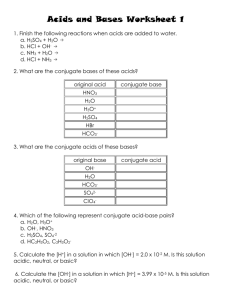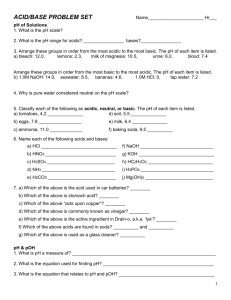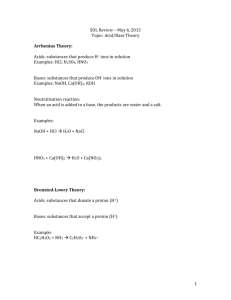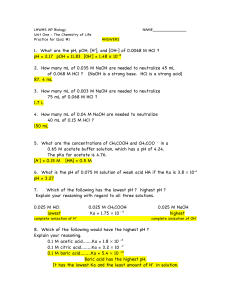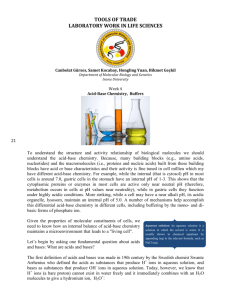pH Question Answers
advertisement
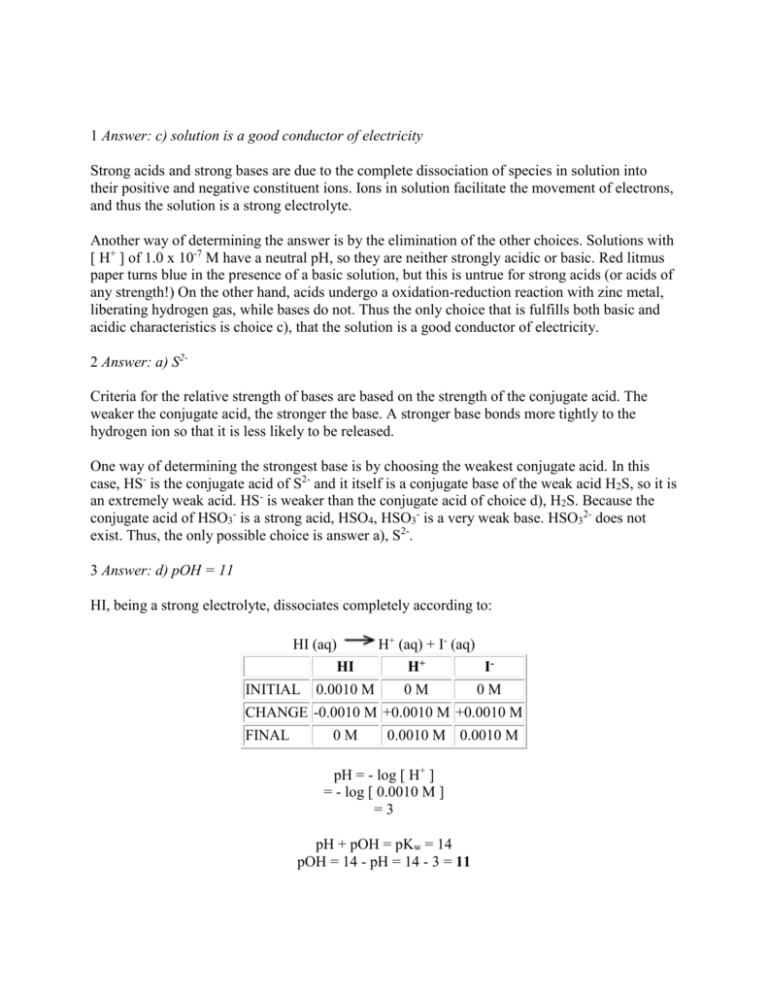
1 Answer: c) solution is a good conductor of electricity Strong acids and strong bases are due to the complete dissociation of species in solution into their positive and negative constituent ions. Ions in solution facilitate the movement of electrons, and thus the solution is a strong electrolyte. Another way of determining the answer is by the elimination of the other choices. Solutions with [ H+ ] of 1.0 x 10-7 M have a neutral pH, so they are neither strongly acidic or basic. Red litmus paper turns blue in the presence of a basic solution, but this is untrue for strong acids (or acids of any strength!) On the other hand, acids undergo a oxidation-reduction reaction with zinc metal, liberating hydrogen gas, while bases do not. Thus the only choice that is fulfills both basic and acidic characteristics is choice c), that the solution is a good conductor of electricity. 2 Answer: a) S2Criteria for the relative strength of bases are based on the strength of the conjugate acid. The weaker the conjugate acid, the stronger the base. A stronger base bonds more tightly to the hydrogen ion so that it is less likely to be released. One way of determining the strongest base is by choosing the weakest conjugate acid. In this case, HS- is the conjugate acid of S2- and it itself is a conjugate base of the weak acid H2S, so it is an extremely weak acid. HS- is weaker than the conjugate acid of choice d), H2S. Because the conjugate acid of HSO3- is a strong acid, HSO4, HSO3- is a very weak base. HSO32- does not exist. Thus, the only possible choice is answer a), S2-. 3 Answer: d) pOH = 11 HI, being a strong electrolyte, dissociates completely according to: HI (aq) HI INITIAL 0.0010 M H+ (aq) + I- (aq) H+ I0M 0M CHANGE -0.0010 M +0.0010 M +0.0010 M FINAL 0M 0.0010 M 0.0010 M pH = - log [ H+ ] = - log [ 0.0010 M ] =3 pH + pOH = pKw = 14 pOH = 14 - pH = 14 - 3 = 11 Alternate solution: Kw = [ OH- ][ H+ ] [ OH ] = Kw / [ H+ ] = [ 1.0 x 10-14 ] / [ 1.0 x 10-3 ] [ OH- ] = 1.0 x 10-11 - pOH = - log [ OH- ] = 11 Both methods are valid. Notice that a low pH corresponds to a high pOH (Section 2). Thus the pOH = 11, which is choice d) 4 Answer: c) 50 mL NaOH and HCl are a strong base and a strong acid, respectively. The reaction of a strong base and a strong acid will have an equivalence point at a pH of 7. The simplified reaction equation is: H+ (aq) + OH- (aq) H2)O (l) Once the pH is recognized as the equivalence point, the question simplifies to: How many millilitres of 0.40M NaOH are needed to react completely with 100 mL of 0.20 M HCl? Like Question 7, there are two methods to answer the question. It is most beneficial to understnad both and to choose the mothod you feel most comfortable with. Method 1 Stoichiometric calculation: moles of HCl to be reacted: 0.100 L x 0.20 mol/L = 0.020 mol HCl HCl and NaOH react in a 1:1 ratio: 0.020 mol NaOH needed mL of NaOH = 0.020 mol / 0.40 mol/L = 0.050 L = 50 mL NaOH This can be written as: 0.100 L HCl x 0.20 mol/L HCl x 1 mol NaOH / 1 mol HCl x 1 / 0.40 mol/L NaOH = 0.050 L NaOH Method 2 If you require equal moles of NaOH to HCl in order to fully neutralize the HCl, then having 100 mL of 0.20 M HCl and a solution of NaOH which is twice as concentrated would require half as much volume to get the same number of moles. Thus 50 mL of NaOH are needed to bring the pH to 7. 5 Answer: a) Ka = [ H+ ] The equilibrium constant expression of any weak acid can be represented as: Ka = [ H+ ][ X- ] / [ HX ] where X- is the conjugate base of the acid, HX. In the case of a buffer system which has equal concentrations of conjugate acid and base, Ka = [ H+ ] x [ X- ] / [ HX ] = [ H+ ] x 1 = [ H+ ] Buffer solutions exist at many pH's: an acetic acid - acetate ion buffer has a pH around 4.7, while a hydrocyanic acid - cyanate ion buffer has a pH around 9.2. Although buffers with equal concentrations of acid and base are equally effective at neutralizing small additions of both acid and base, large additions of acid or base will exceed the buffer capacity. Thus buffers are specific to a small pH range, rather than bulk effectiveness throughout the pH spectrum. pKa only equals pKb if the buffer is exactly neutral. Most buffers are not neutral (see point above). Thus, the answer is choice a) Ka = [ H+ ]. 6 Answer: c) 7 What is the major contributor of H+ in the equilibrium? From HCl, which dissociates completely, [ H+ ] = 1.0 x 10-8 M. From water, which dissociates weakly, [ H+ ] = 1.0 x 10-7 M. Thus, water is the major contributor of [ H+ ] and the pH is: pH = -log [ H+ ] = -log [ 1.0 x 10-7 M ] = 7. 7 Answer: d) ii) and iii) only Strong acids (Section 3) are substances which dissociate completely in water, releasing H+ ions. To facilitate this release of H+ ions, the bond between the molecule and its H atom must be highly polar and weak so that the bond is easily broken. There are several ways to ensure a highly polar bond: Electron Drift: the electrons surrounding the H+ nucleus are attracted AWAY from the H+ nucleus. Electronegative molecule: this will attract the electrons to facilitate electron drift. A central atom with a high oxidation number generally means that it is bonded to several oxygens. The greater the number of oxygens, the more electronegative the molecule due to the high electronegativity of the oxygen atoms. Options ii) and iii) are thus correct, which is choice d). 8 Answer: a. Na2C2O4 A high pH corresponds to a basic solution. All the choices are strong electrolytes and dissociate entirely in aqueous solution. Na2C2O4 dissociates into Na+ and C2O42-. Na+ is a spectator ion. C2O42-, the oxalate ion, is the conjugate base of the diprotic weak acid H2C2O4, oxalic acid. This solution will be basic. KC2H3O2 dissociates into K+ and C2H3O2-. K+ is a spectator ion. The acetate ion, however, is basic in solution. NaHSO4 dissociates into Na+ and HSO4-. Again, Na+ is a spectator ion. HSO4- is the conjugate base of the strong acid H2SO4, which means that it is an extremely weak base. In fact, it itself ionizes to form H+ and SO42- in solution, which is acidic. NH4NO3 dissociates into NH4+ and NO3-. This time the spectator ion is NO3-. NH4+ is the conjugate acid of the weak base NH3, and the solution will be acidic. Only Na2C2O4 and KC2H3O2 form basic solutions. C2O42-, being the conjugate base of the second ionization is a stronger base than C2H3O2- which is the result of a single ionization. Thus Na2C2O4, choice a), will form a solution of the highest pH. 9 Answer: asparagine To solve this problem, we must find the pKa values of the amino acid, which we can then use to identify the amino acid. This is done with regular weak acid calculations. We will assume that the two pKa values are far enough apart that only two major species will be present at each of the points described in the question, and check that assumption later. Point 1: We know the final pH, so we can calculate the equilibrium concentration of H+. [H+]eq = 10-pH [H+]eq = 10-2.46 [H+]eq = 3.47x10-3 I.C.E. table: H+ 0M A0M INITIAL HA 5.00x10-3 M CHANGE - 3.47x10-3 M + 3.47x10-3 M + 3.47x10-3 M EQUILIBRIUM 1.53x10-3 M 3.47x10-3 M 3.47x10-3 M Ka = (3.47x10-3 M)2/(1.53x10-3 M) Ka = 7.87x10-3 pKa = -log(7.87x10-3) pKa = 2.1 Point 2: Again, we can calculate the equilibrium concentration of H+. [H+]eq = 10-pH [H+]eq = 10-9.38 [H+]eq = 4.17x10-10 I.C.E. table: H+ HA INITIAL CHANGE 5.00x10-10 M -3 A- 0M - 4.17x10 M + 4.17x10 0M -10 M + 4.17x10-10 M EQUILIBRIUM 8.3x10-11 M 4.17x10-10 M 4.17x10-10 M Ka = (4.17x10-10 M)2/(8.3x10-11 M) Ka = 2.10x10-9 pKa = -log(2.10x10-9) pKa = 8.7 The two pKa values are very far apart, so our assumption that only one dissociation will be taking place in appreciable amounts at each pH is valid. Now, we simply look at the table of pKa values for the twenty amino acids, and find the one with pKa values 2.1 and 8.7. That one is asparagine. Second Set of questions starting at #9 1. When HI dissolves in water, which ions are formed? a. H3O+ and H2I+ *b. H3O+ and Ic. H3O+ and OHd. OH- and H2I+ e. OH- and I2. Which of the following properties would indicate an acid? I. pH less than 7 II. Turns litmus paper to a blue color. III. Turns phenolphthalein to a pink color. *a. I only b. II only c. I and II d. I and III e. II and III 3. Which of the following reactions would indicate a base? a. reacts with water to give H3O+ b. reacts with water to give H2 c. reacts with a metal to give H2 d. reacts with HCO3- to give CO2 *e. reacts with NH4+ to give NH3 4. An electron pair acceptor is: *a. an acid. (Lewis definition) b. a base. 5. Write a complete balanced equation using the Arrhenius concept for the reaction between sulfuric acid and potassium hydroxide. H2SO4 + 2 KOH --> K2SO4 + 2 H2O 6. What is the pH of a solution in which [H3O+] = 0.005 M? pH = -log(0.005) = 2.3 7. What is the [OH-] in a solution with pH = 5? [OH-] = 1 x 10-9M 8. The concentration of OH- ions in a certain fruit juice is 1 x 10-11M. What is the concentration of hydronium ions? What is the pH of the juice? [OH-] = 1 x 10-11M pOH = 11 [H3O+] = 1 x 10-3M pH = 3
